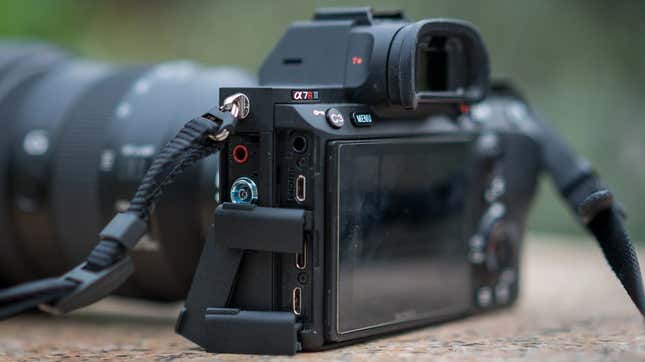
The earliest mirrorless cameras played catchup to DSLRs, which have decades of development behind them. Today’s models are different, capable of everything from professional portraits and video to documenting a night out.
One of the biggest problems early mirrorless cameras had was battery life, going dead after much fewer shots than their DSLR counterparts. Today’s models hold their own, with accessories like battery grips extending their life even further. In fact, today’s mirrorless cameras outperform DSLRs in some areas, notably autofocus and high-ISO image quality.
Led by Sony, pretty much every mirrorless model from Nikon to Canon and beyond now has highly effective eye autofocus. More expensive cameras like the R5 or A1 can crank their ISO ridiculously high without grain. Their electronic shutter also allows for nearly silent shooting, fantastic for journalists and wedding photographers, as well as extremely high burst rates.
That’s not to say that the DSLR is dead—there are plenty of high-end pro models like the D850 and 1DX that turn out amazing images and video while sometimes costing less than comparable mirrorless models. That said, the future appears to be mirrorless, with Sony and Canon halting development on DSLRs and Nikon rumored to follow suit soon according to reports from July of this year.
What to Look For in a Mirrorless Camera
A camera is a tool. Which camera is the best for you depends on what job you need that tool for. Sports and wildlife shooters might want something with a high burst rate and low buffer to capture split-second shots. Fashion pros working in the studio will want eye autofocus (to lock onto the subject’s eyes without having to manually move an autofocus point in the viewfinder), high resolution, and possibly a high flash sync speed for creative and beauty work. Landscape shooters need something with high resolution that can take a beating in the real world. So consider the kind of work you do, or want to do, when you’re shopping for that new mirrorless camera, and let that guide your decision.
There are a few things most people will want out of their next (or first) mirrorless camera no matter what: fast autofocus, high resolution, high dynamic range, fast shutter speed, and clean high-quality video files are all features that the cameras on this list have in common. And all of them will produce good results, though the higher-end models will have fancier features than others.
Methodology
As a freelance photographer, I’m drawing on my personal experience and what I think makes for a great camera when I pick my recommendations. I thought about what the best camera for each category would be based on which features it had, the ecosystem of good lenses available, and what you get for the price. You won’t see many of the very newest releases, here because they still need to be tested more thoroughly in the real world to see how they stack up against the mainstays that’ve been around for at least the last couple years.
Though I do have experience doing this work, I sadly can’t review every model out there. So I drew on the expertise of professional photographers and reviewers who were able to get their hands on this gear for many of these recommendations.
With that out of the way, let’s get started.
The Best Mirrorless Cameras
This is, honestly, a tough category to review, as the technology for mirrorless cameras is advancing at a truly rapid pace. In just a few years, they’ve gone from niche category to serious mainstream contender, with the big three (Nikon, Canon, and Sony) heavily focusing their R&D efforts on this tech going forward. For anyone unfamiliar with mirrorless, DSLRs have a mirror that flips up when you take a photo, which directs light to your eye through the optical viewfinder when it’s down so you can see your shot. Mirrorless cameras do away with the mirror and make everything digital, including your viewfinder. All that moves when you take a photo is the shutter, and what you see through the viewfinder is transmitted electronically to your eye. Instead of light coming directly through the lens, your viewfinder becomes a tiny screen that transmits data from the camera’s sensor so you can see it.
Before we get into the list I want to be clear: gear only takes you so far. Dropping enough money to buy a small passenger sedan doesn’t guarantee brilliant, artistic shots or stunning video. It can help you get them, but you’ll have to develop your skills first. If you’re new to photography, or to the mirrorless world, you’ll fare very well with a less expensive model while you learn the ropes—start with a body and a lens or two, learn the basics, and work up from there. You’ll get the most out of your tools once you understand how to use them and you’ve developed your creative eye.
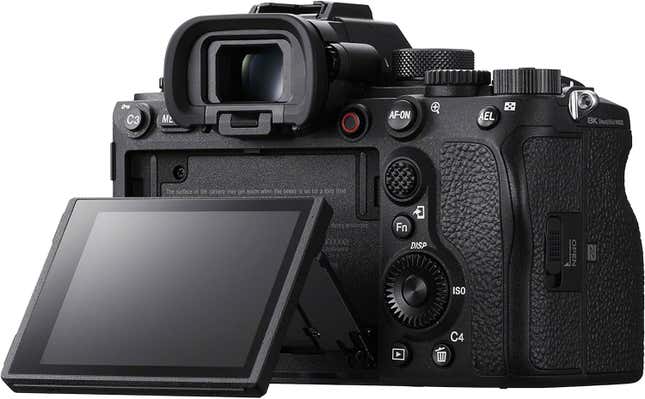
The Best Mirrorless Camera Overall: Sony A1 — $6,499.99
Pros:
- High resolution sensor
- Super fast burst rate
- Pro level video capability (4K and 8K options)
- Fast and highly accurate eye autofocus
Cons:
- One of the most expensive cameras on the market right now
An immense 50 megapixels of power combined with a burst rate of up to 30 frames per second on electronic shutter mode give the Sony A1 serious muscle. Hands-on reviews show you can shoot at that frame rate for about five seconds, so about 150 images, before the buffer kicks in and you have to wait while the camera finishes writing the images to the memory card. Even when the buffer activates, it’s cleared in about a second. If you’re a fast-action photographer and have the cash to drop, this is your rig.
The A1’s two memory card slots take CFexpress or SD cards. If you’ve got the extra money, CFexpress cards write images more quickly than even the fastest SD cards, a must if you’re funnelling a ton of high-res images onto the card at 30FPS. If not, high-speed SD cards should do just fine.
The A1 has the same human eye autofocus made famous by previous Sony models as well as animal and bird eye autofocus. It shoots 8K video, and can record 4K video in slow motion. Live tracking autofocus is very fast and accurate in hands-on tests, with autofocus points covering 92% of the camera’s field of view. The 50 megapixel sensor collects a ton of data, which means you get excellent dynamic range and recovery of highlights and shadows from your RAW files.
Basically, this camera can handle anything you throw at it, and do it well. But that performance comes with a hefty price tag. Remember when I mentioned dropping enough money for a car? Add lenses and you can easily spend over $10K here.
But you don’t have to drop that kind of cash to get pro-level performance from a Sony. A used A7R4 with a whopping 61 megepixels of resolution will run you around $2,300 in like-new condition. Add a lens and you’re still probably spending half what you’d drop on the A1 for a legitimate professional rig. Not a Sony shooter? Nikon’s Z9 is a professional powerhouse with high-res images that’s great for fast-action shooting.
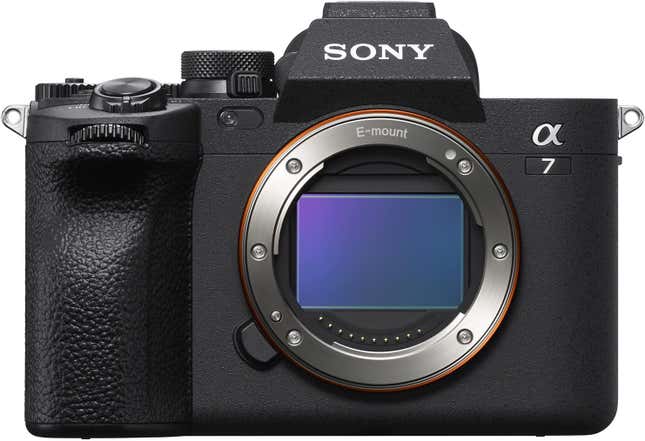
Best Hybrid Mirrorless Camera: Sony A7IV — $2,499.99
Pros:
- Pro-level performance for less
- Higher resolution than most entry level full frame cameras
- Great all-around performer
- Lots of options for glass
Cons:
- Relatively low burst rate at 10FPS, so not great for fast-action
Sony’s successor to the popular A7III is by many accounts the best hybrid shooter available right now for the money. Sensor resolution’s been bumped up from 24.2 megapixels to 33, just a bit beyond Canon’s popular 5DMK IV DSLR. Sony’s also given the A7IV a faster processor for more rapid image handling. In fact, this camera uses the same processor as the much pricier A1—but not the same sensor. It actually has some features, like focus mapping and focus breathing compensation, that the A1 doesn’t.
The A7IV’s video capabilities also impress. It can do a lot of what the more expensive, specialized-for-video A7SIII can at about $1K less. Good enough to film high-quality video for weddings, commercial work, a YouTube channel, or social media.
This camera’s strength isn’t that it does one thing better than everyone else, but that it does a lot of things very well, especially for the price point. That makes it an excellent entry level or backup camera for aspiring pros, and it’s definitely capable of pro work—photographer and YouTuber Manny Ortiz said in his video review that, after testing it for months, he’d pick this camera over his A1 or A7SIII if forced to pick one camera body for all his work.
Sony’s also stacked up an impressive array of third-party lenses compatible with its Alpha lineup, including glass from Sigma’s Art line. Mirrorless gear is still more expensive than DSLR, so it helps to be able to enter that ecosystem on a budget. Even with the rapidly advancing tech of mirrorless systems, this camera body should last you years.
If you’re committed to the Canon system and have a little more to spend, the R5 is a solid professional mirrorless camera body. 45 megapixels of resolution and 8K video capture make it worth the extra coin.

Best Beginner Mirrorless Camera: Nikon Z6II — $1999.95
Pros:
- Good ergonomics
- Robust lineup of quality lenses
- Good image quality
- Can be a hybrid camera
Cons:
- Not the absolute best autofocus
- Dual memory card slots each accept a different kind of card
- Not quite as powerful as others in this price bracket
Nikon has always made cameras that were pretty easy to pick up and use (my main camera right now is a Nikon D750), and its mirrorless line continues that legacy. The menus are relatively easy to navigate, the ergonomics make Nikon cameras easy to hold, and the images are stellar. If you’re new to the mirrorless world and want something you can learn on that will still make good images and video, check out the Z6II.
While the original Z6 is a perfectly good camera, the second generation offers a few upgrades that make it a little bit better if you can afford it. Nikon’s mirrorless lens lineup is also impressively high quality—even the standard 35 and 50mm 1.8 lenses have been lauded for their sharp images that render great color. If you’re coming from a Nikon DSLR, the FTZ adapter lets you use those lenses, albeit with a slight crop since the adapter puts the lens farther away from the sensor mount.
The autofocus system on the Z6II isn’t the best out there, but it’s pretty fast. The eye AF system holds its own against Sony and Canon, and Nikon’s super-wide lens mount allows more light to get to the sensor. That’s let them make some ridiculously fast lenses—like the 58mm f/0.95 Noct and 50mm 1.2.
Pair this camera with some good glass, and you’ve got a solid, relatively inexpensive all-rounder mirrorless camera suited to a range of professional shooting scenarios. For a very evenhanded review of this camera before and after a pivotal firmware update and six months of use, check out this video from photographer and videographer Dan Watson.
The original Z6, while not as fast, is still a good budget option if you’ve got your heart set on the Nikon Z system but need something more affordable.
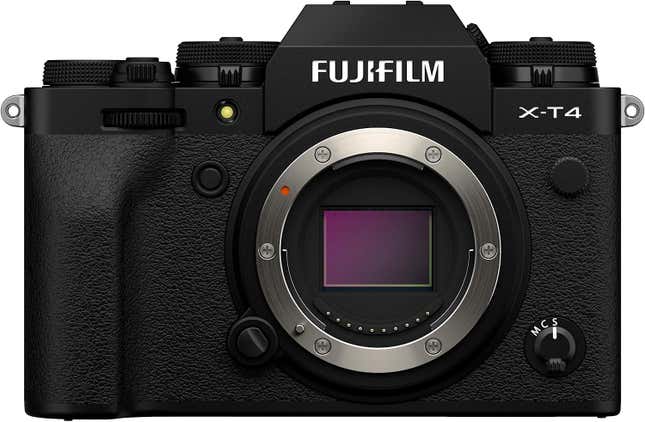
Best Mirrorless Camera for Travel: Fuji XT-4 — $1699.95
Pros:
- Stills that hold up against full-frame competitors
- 4K video
- Articulating screen
- Compact, retro design
- Longer battery life than previous XT models
Cons:
- Image quality not quite as good as full frame
- Not as much dynamic range as full frame images
Fuji’s XT-4 improves on the already outstanding quality of its predecessors in a compact package that’s perfect for travel. Added in-body image stabilization (IBIS) and a shooting speed of up to 20 frames per second mean you aren’t trading power for portability, either.
This is an APS-C camera, meaning its image sensor is smaller than a full frame camera’s 35mm equivalent sensor. Even so, it still holds its own against full frame mirrorless cameras at the same price point. And Fuji’s lenses have a reputation for impressive quality despite their compact size.
The XT-4 has a 26 megapixel sensor and can record 4K video. Its compact build makes it a favorite of many street photographers, and the retro design aesthetic just makes this a fun camera to use. The 12 included film simulations let you add an interesting, vintage look to those Instagrammable shots of cobblestoned streets and cafes right in-camera.
The fully articulating (read: flippy) rear screen is great for vlogging or self portraits. It’s not the most powerful option out there, but if you’re looking for a quality camera that’s easy to pick up and shoot with while you’re on the go, can fit in your backpack, and feels fun to use, you’d be hard pressed to find something better.
For a deep-dive review after a year of using this camera, check out this video from YouTube channel The Hybrid Shooter, or this one from photographer Andrei Dima.
Another great compact option is Sony’s A7C, a tiny full-frame camera that packs almost the same capabilities as the A7III into a camera small enough to throw in a fanny pack.
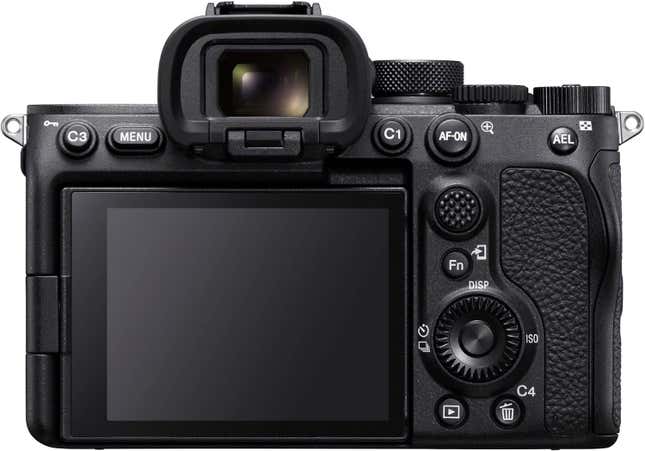
Best Mirrorless Camera for Video: Sony A7SIII — $3499.99
Pros:
- Great low-light performance
- Shoots in pro video codecs
- Lightweight design
- Good ergonomics
Cons:
- Higher price tag
- Not the best hybrid shooter out there
- Not for people just starting out in video
Built specifically for video, Sony’s A7SIII camera has a 12 megapixel sensor that works especially well in low-light conditions that other cameras might find challenging. While that doesn’t make it the best camera for crazy-sharp stills, it’s a favorite among pro videographers.
The A7SIII fits a lot of power into a body just as lightweight as other mirrorless cameras. It can shoot 4K ultra HD footage, and borrows the enhanced ergonomics of its siblings the A7RIV and A9. IBIS helps cut camera shake for smooth footage, and Sony’s impressive range of both brand-name and third-party lenses mean your b-roll will come out looking crispy and cinematic.
The A7SIII also doesn’t force you to use more expensive CFexpress cards. You can (and probably should if you can afford to), but it also takes SD cards. Two slots mean two cards, so you can back up your footage by writing to both simultaneously. Its rear display is fully flippy for self-filming, and there are plenty of attachments and ports for extras like external monitors, gimbals, etc. to expand the camera’s capabilities further. For an extensive video review of this camera’s filming capabilities, check out filmmaker Brandon Li’s take on the camera here.
One caveat: this is very much designed for professional video shooters. If you’re looking for a true hybrid stills and video camera, you’ll be able to get something better for a lower price point than the A7Siii’s $3,500. If you want to get into video and stick with Sony, I’d recommend the A7IV or A7III. Other great, more affordable mirrorless cameras for video include Nikon’s Z6II and the Fuji XT-4.
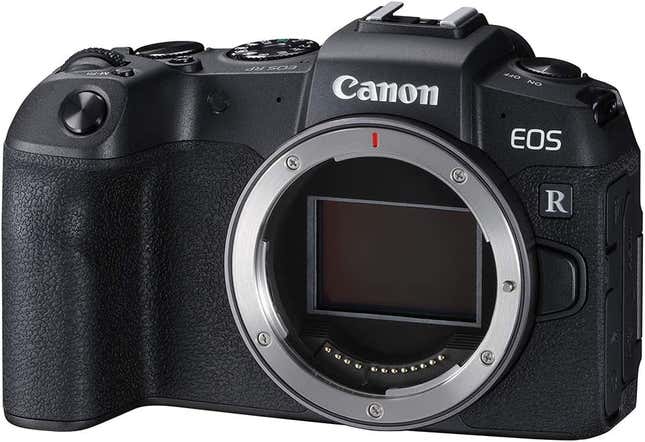
Best Budget Mirrorless Camera: Canon EOS RP — $999.99
Pros:
- Very affordable
- Good stills and video for this price range
- Variable angle screen
- Low-cost entry into mirrorless
Cons:
- Not as feature-packed as more premium cameras
- No in-body image stabilization
- Slow burst rate
The Canon EOS RP is probably the cheapest entry point to the world of full-frame mirrorless at around $1,300 brand new for the camera body and a kit lens. And it doesn’t sacrifice much in quality to reach that price.
The RP shoots a perfectly respectable 26.2 megapixels, on par with more expensive mirrorless cameras like the A7III or Nikon Z6. It also shoots 4K video, with a variable angle screen so you can use it for vlogs and photography. The back display is also touchscreen, so you can tap and drag your focus point in live view. Pair this camera with one of Canon’s immaculate RF lenses, and you’ve got surprising power and modern tech for not a lot of money.
For a demonstration of the RP’s video quality, check out photographer/videographer/YouTuber extraordinaire Peter McKinnon’s side-by-side comparison with the slightly more high-end EOS R. Looking at the clips, it’s nearly impossible to tell which is which.
That said, there are a few sacrifices Canon had to make to cut the cost. You won’t find the top LCD display that Canon includes with others in the R lineup on this camera. It also doesn’t have in-body image stabilization (though there are lenses you can use with it that do). And you won’t be using this body to shoot sports—the burst rate is only 5 FPS at the fastest.
Overall, this camera’s video and stills capabilities make it great for anyone who wants to get into mirrorless on a budget, from amateur photographers to aspiring videographers.
It seems like more mirrorless cameras are released every week, so I’m sure this list will get shaken up before too long, but right now these cameras are among the very best. Here’s hoping I’ll be able to get my hands on the newest releases soon enough, but this is going to do it for now. If you’re a professional photographer, or just like taking photos, leave a comment with which gear you use and why. I’m always interested to see what other people shoot.

